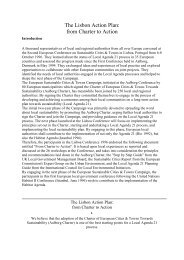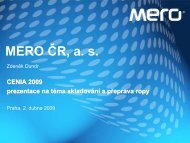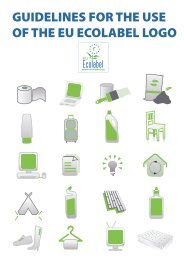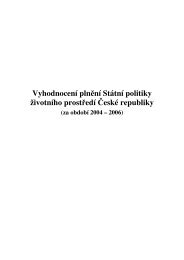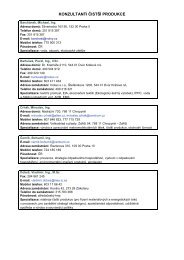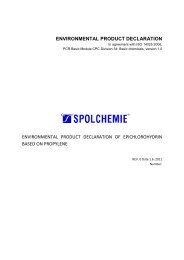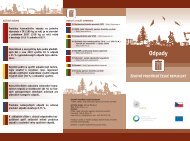Environmental Technologies and Eco-innovation in the Czech ...
Environmental Technologies and Eco-innovation in the Czech ...
Environmental Technologies and Eco-innovation in the Czech ...
You also want an ePaper? Increase the reach of your titles
YUMPU automatically turns print PDFs into web optimized ePapers that Google loves.
Spolek pro chemickou a hutní<br />
výrobu, a.s., based <strong>in</strong> Ústí nad Labem<br />
(Spolchemie) implemented a unique<br />
technology developed by its own<br />
specialists. The technology consists<br />
of epichlorhydr<strong>in</strong>e production from<br />
a renewable raw material resource (one<br />
of <strong>the</strong> by-products of biofuel production<br />
– glycer<strong>in</strong>e). Spolchemie began trial<br />
operation of a new production unit at<br />
<strong>the</strong> beg<strong>in</strong>n<strong>in</strong>g of 2007. After two years<br />
of operation, all <strong>the</strong> production l<strong>in</strong>e’s<br />
design parameters have been fulfilled.<br />
The technology is protected by a patent<br />
<strong>in</strong> which many <strong>in</strong>ternational producers<br />
are very <strong>in</strong>terested. A unit based on<br />
Spolchemie’s know-how is about to be<br />
constructed abroad.<br />
7.4 | Chemical products safe for streams<br />
All products that could cause water pollution are tested for biodegradability <strong>and</strong><br />
toxicity for water organisms. Chemical substances that are not biodegradable or are<br />
toxic for water organisms cannot be conta<strong>in</strong>ed <strong>in</strong> such products.<br />
In larger towns <strong>and</strong> villages, detergents are lead <strong>in</strong>to waste water treatment plants<br />
to be biologically treated. However, <strong>in</strong> smaller villages, <strong>the</strong>y are often discharged<br />
directly <strong>in</strong>to streams (through septic tanks or home treatment plants that might not<br />
fully treat <strong>the</strong> water). Therefore, <strong>the</strong>re is an obligation <strong>in</strong> <strong>the</strong> <strong>Czech</strong> Republic that all<br />
detergent <strong>in</strong>gredients shall be tested for biodegradability.<br />
Water conta<strong>in</strong>s calcium <strong>and</strong> magnesium salts that affect <strong>the</strong> wash<strong>in</strong>g process <strong>and</strong><br />
cause water hardness. Therefore, detergents shall conta<strong>in</strong> <strong>in</strong>gredients that lead to<br />
water soften<strong>in</strong>g. To suppress <strong>the</strong> effect of calcium <strong>and</strong> magnesium salts, phosphorus<br />
compounds were formerly added to detergents. However, higher amounts of phosphates<br />
cause water eutrophication, which is a process of enrich<strong>in</strong>g water with nutrients,<br />
especially nitrogen <strong>and</strong> phosphorus. Excessive amounts of nutrients support <strong>the</strong><br />
growth of phytoplankton, which can cause problems for some people who swim <strong>in</strong> water<br />
with higher phytoplankton concentrations. Water bloom fur<strong>the</strong>r aggravates treat<strong>in</strong>g<br />
both potable <strong>and</strong> <strong>in</strong>dustrial water <strong>and</strong> may cause oxygen reduction <strong>in</strong> water <strong>and</strong> <strong>the</strong><br />
subsequent death of organisms (fish, mussels). Therefore, phosphates are now be<strong>in</strong>g<br />
replaced <strong>in</strong> detergents by molecular sieves 9 (zeolites). These are substances that<br />
9 molecular sieves – crystall<strong>in</strong>e microporous materials able to b<strong>in</strong>d calcium <strong>and</strong> magnesium salts




